Behavioral Ecology - Exam 3
1/89
Earn XP
Description and Tags
ZOO 425 Exam 3 - Spring 2025
Name | Mastery | Learn | Test | Matching | Spaced |
|---|
No study sessions yet.
90 Terms
game theory
the relative fitness of a strategy depends on all the game’s strategies
John Maynard Smith
adapted GT to ecology
GT
formally describe the game rules
formal mathematical description of the game strategies
analytical solutions and simulations
Evolutionarily Stable Strategy (ESS)
a strategy that when adopted can’t be invaded by another strategy
Pure ESS
one strategy “wins”
mixed ESS
has more than 1 strategy “win”
aggression payoff matrix
hawk strategy - always fight
dove - never fight
payoff of victory - V
cost of lost fight - C
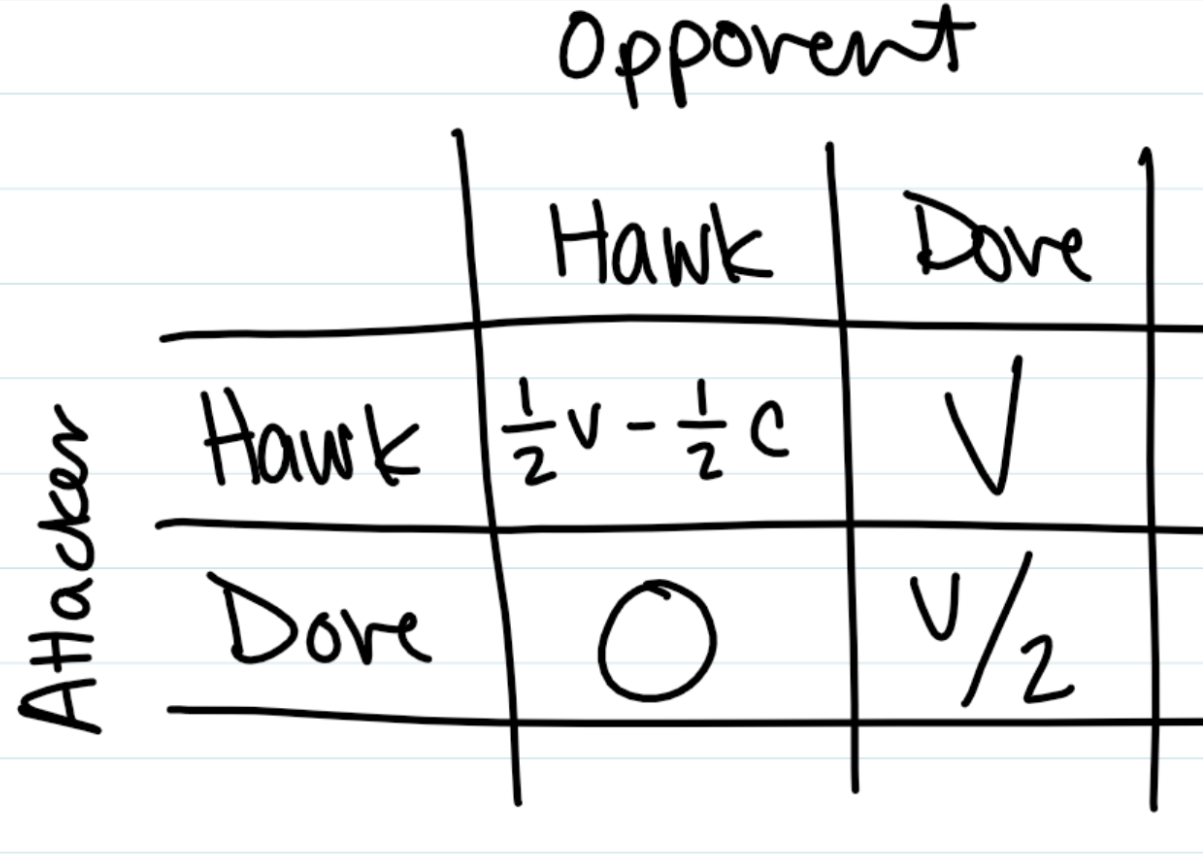
proportion of hawks
h = V/C
proportion of doves
(1-h)
hawk payoff
H = h(½ V - ½ C) + (1-h)V
dove payoff
D = h(0) + (1-h)V/2
equilibrium
H = D
change in V and C changes ESS and h at ESS
V>C = no dove invasion, always better to fight (pure ESS; low C)
C>V = hawk invasion (mixed ESS)
stable polymorphism
only has one strategy (can’t change)
mixed strategy
can choose the strategy and the probability of being agressive is h
GT and aggression predictions
the best strategy depends on all other strategies in the game
ESS doesn’t imply individuals are representative of the max payoff at equilibrium
the available strategies effect ESS
new strategies change ESS
V and C vary within the environment and within time
assessment
way individuals try to determine the cost of a potential fight with that individual
winner effects
a win increases the likelihood of another win
loser effects
a loss increases the likelihood of another loss
bystander effect
a bystander is more or less likely to fight if another individual loses or wins a fight the bystander watched
costs of sexual reproduction
offspring only have ½ of your genes
engaging in contests or competitions to find mates
time and energy
risk of predation, parasitism, or disease
benefits of sexual reproduction
genetic variability
brings together adaptive alleles or gene complexes
reduces the load of deleterious mutations (avoids Muller’s Ratchet)
Muller’s Ratchet
asexual reproduction accumulates deleterious mutations and have more difficulty to purge mutations
ansiogamy
2 different types of gametes
sperm
small, mobile, cheap
eggs
larger, immobile, expensive
females should be choosy
because plenty of sperm to choose from to make up for high egg production costs
males should compete to fertilize limited eggs
because of a high success variance causing stronger sexual selection
intersexual selection
pressure between sexes
direct benefit
benefits to females
ex. territory access, nuptial gifts (food), protection, offspring care
good genes
the genetic benefits to offspring based on mate selection to increase offspring fitness
may cause runaway selection and passing on choices
honest indicator
a phenotypic trait that honestly indicates fitness; reproductive state can alter choices
example of honest indicator
immunity (MHC) and scents in humans
females prefer the scent of males with a different MHC
pregnant females (birth control hormones) prefer the scent of males with a similar MHC
intrasexual selection
pressures within sexes
sexual dimorphism
traits that differ between sexes within a species
mating system
the social system that describes how males and females come together to breed (social bonds)
breeding system
the genetic system that describes how males and females come together to breed (genetics)
components of mating systems
number of partners
timing and duration of associations
male and female perspectives of costs and benefits
monogamy
neither sex has the opportunity to monopolize the other
each breeding adult is with one other breeding adult; male PC is essential and non-shareable for offspring success
frequency of monogamy in birds
with genetic tested, determined multiple fathers within nests
polygamy
one sex is able to monopolize the other
one sex has multiple partners
polygyny
1 male with multiple females
strong male sexual selection
little to no male PC
resource defense
one sex has access indirectly through monopolizing critical resources
female defense
males access females directly
male dominance
males display or compete for females who choose mates based on their status
explosive breeding assemblages
high mating sychronization
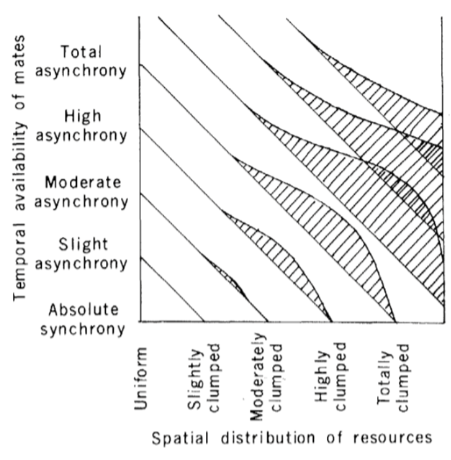
lek
expected when critical resources are abundant and widely dispersed or too unpredictable; too costly to be defendable
polygyny threshold
eventually the female’s cost of being with a male who is with many females becomes too high and it chooses a lower quality male
IFD mate selection (fitness of high and low quality male are equal)
polyandry
1 female with multiple males
female sexual selection
little to no female PC
typically when nest predation rates are high
resource defense
females control males indirectly by monopolizing critical resources
female access
female interactions with themselves limits male access
factors of parental care
degree that parental care influences offspring survival
number of times an adult can reproduce in a season or lifetime
trade-off of current PC and other activities (including future reproduction)
PC payoff matrix
P - probability of offspring survival with a number of parents providing care
assumes P0 < P1 < P2 and P0 << P1 ~ P2 when there’s lots of food
EC - number of eggs a female lays if she cares for offspring
ED - number of eggs a female lays if she deserts offspring
ED > EC
m - probability of a male who deserts will mate again
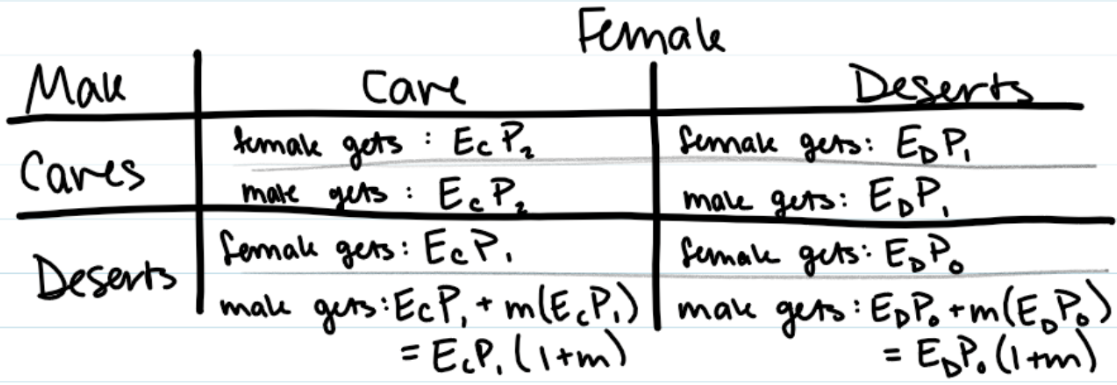
both desert (ESS1)
EDP0 > ECP1 or female will care
EDP0(1+m) > EDP1 or male will care
female deserts and male cares (ESS2)
EDP0 > ECP1 or female will care
EDP1 > EDP0(1+m) or male will desert
female cares and male deserts (ESS3)
ECP1 > EDP0 or female deserts
ECP1(1+m) > ECP2 or male cares
both care (ESS4)
ECP2 > EDP1 or female deserts
ECP2 > ECP1(1+m) or male deserts
Extra-Pair Copulation (EPC)
breeding outside of a monogamous mating system
polygynous breeding system and monogamous mating system
female EPC benefits
increased offspring genetic diversity
increased fertilization
decreased likelihood of female harassment or offspring infantilization
trading up
trading up
females getting the best of both PC (from mating pair) and genetic quality (from breeding pair)
female EPC costs
partner retaliation
disease, parasite transmission, predation
uncertain quality of extra-pair (less assessment)
risk of injury
male EPC benefits
increased offspring production
male EPC costs
sperm depletion
disease, parasites, predation
injury by extra-pair’s mating partner
increased risk of cuckoldry
dissolution of social bonds
Extra-Pair Paternity (EPP)
proportions of copulations by EPC; less likely with increased PC
classic female choice
choice of mate made pre-insemination
ex. courtship, nuptial gifts, territory quality
courtship behaviors
provides opportunity for assessment and comparing male phenotypes
cryptic female choice
mate choice made post-insemination, choice of high quality sperm
ex. sperm train, fowl sperm ejection to prevent insemination by subdominant males
mate guarding
male only cares about guarding when the other bird is male and their mate is fertile
don’t waste time or energy when female isn’t reproducing
pre-insemination
sperm compeition
head start (ex. locking, plugging)
displace or remove other sperm
change frequency of copulation
change sperm investments (ex. strategic investments)
locking
benefits - physical guarding is more effective
costs - time and energy not used for other activities
plugging
benefits - time and energy available for other activities
costs - not as effective as locking (plug can be removed)
strategic sperm investments
increased investment with presence of other males
female mating status - priority over insemination order or quantity
female size
future opportunities (ex. sperm depletion, coolidge effect)
sperm depletion
high dominance males have increased initial copulations, but decreased with increased number of copulations
coolidge effect
males exhibit renewed interest in mating when a new female is introduced
reserved sperm for new female, not depleted
alternative strategies
each individual has a specific phenotype and strategy that doesn’t change in their lifetime
frequency-dependent selection determines proportion of strategies
ex. Coho Salmon - hooknose (fight) and jack (sneak)
each strategy works best when it’s rare
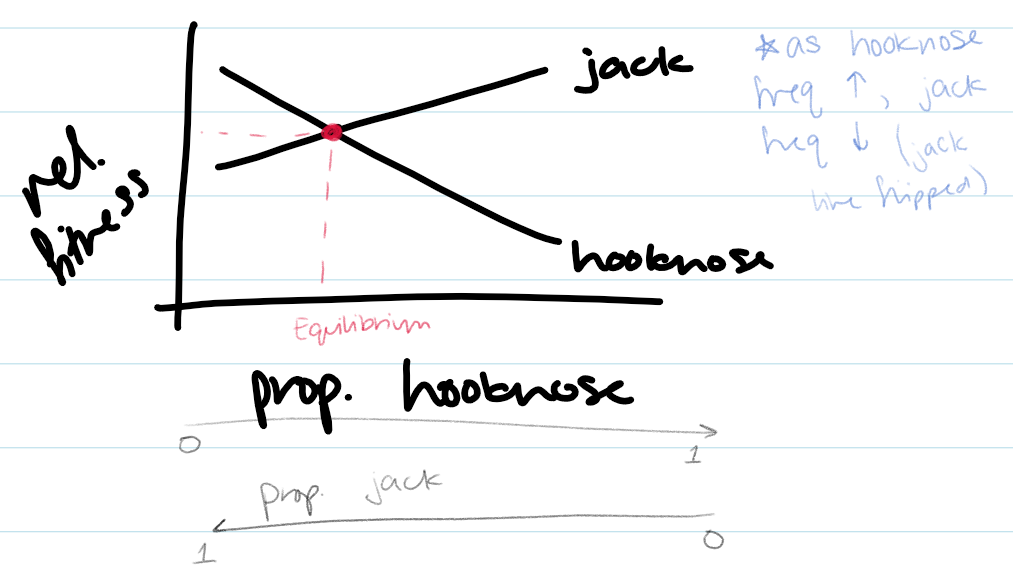
conditional strategies
behavioral assessments of individual status causes individual to choose their strategy
relative fitnesses ≠ and the individual chooses the strategy with the higher fitness
depends on individual’s status
switchpoint - = fitness between strategies
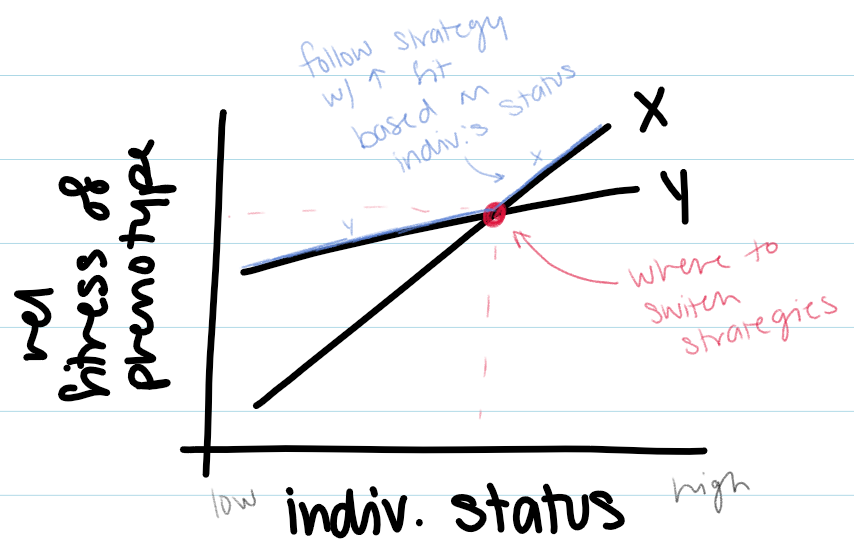
sequential hermaphroditism
changing sex
protogynous hermaphrodite
female changes to male
protandrous hermaphrodite
male changes to female
changing environmental conditions
changes in environmental conditions = changes in strategy fitnesses = change in equilibriums = change in strategy frequencies
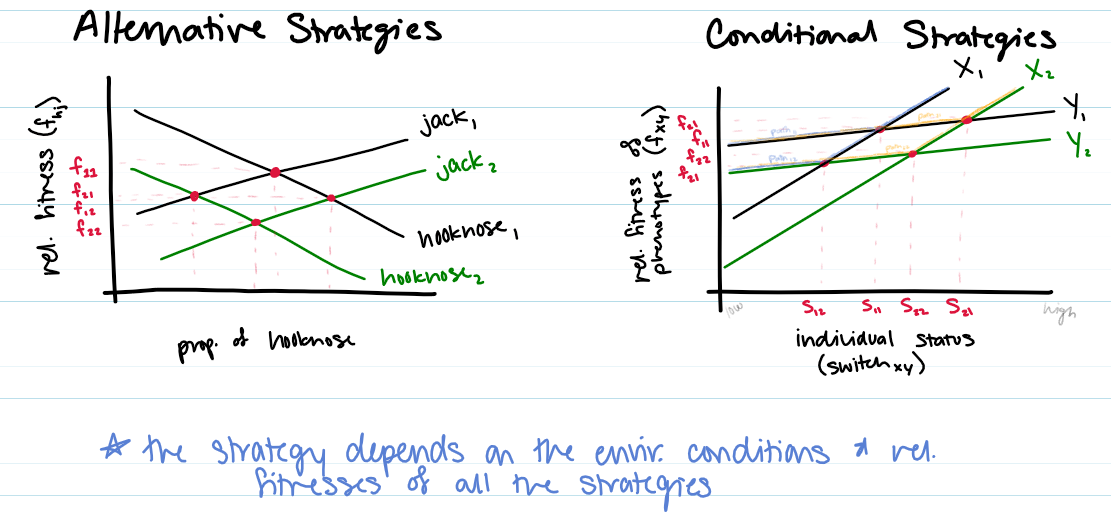
mutualism
benefits both parties immediately
kin selection
the evolution of characteristics that favor the survival (and reproduction) of close relatives of the affected individual
Hamilton and Haldane
kin selection important figures
direct fitness
genes contributed by an individual via personal reproduction in the bodies of surviving offspring (the individual’s offspring)
indirect fitness
genes contributed by an individual via survival in the bodies of offspring of a related individual (a relative’s offspring)
coefficient of relatedness (r)
the pathway that connects focal individuals
(pathway form individuals)number of path + (individual pathways)number of paths = r
Hamilton’s Rule
r(benefitrecipiant) > costaltruist
rB > C
alarm calls
who calls - females (sometypes/rarely males)
typically with female PC and not male
who are called to - offspring and sometimes other kin
Emlen and Oring 1977
describes different mating systems based on the ability to monopolize mates within different spatial and temporal ecological conditions
Gross 1996
describes alternative strategies, mixed strategies, and conditional strategies and describes developmentally fixed or plastic alternative
alternative - genetic polymorphisms with equal fitness with frequency-dependent selection
mixed - theoretical strategy of a mix of strategy tactics
conditional - choice of strategy based on individual status, environmental status, and density of strategies
switchpoint
developmentally fixed - hormones play a roll in pre-adult to determine phenotype, but don’t change as adults
developmentally plastic - hormones play a roll in adults changing tactics, hormones play a roll in adulthood